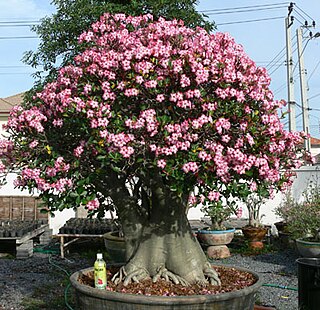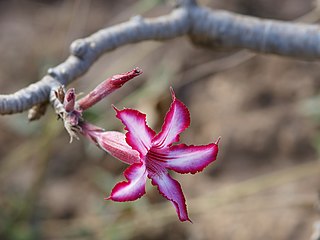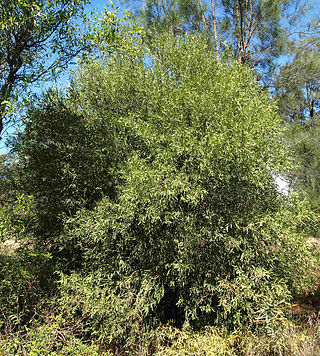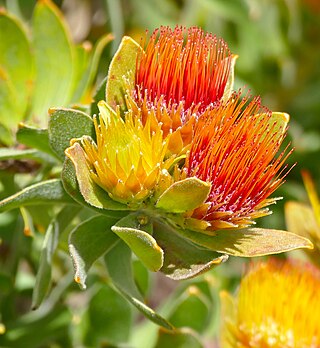
Apocynaceae is a family of flowering plants that includes trees, shrubs, herbs, stem succulents, and vines, commonly known as the dogbane family, because some taxa were used as dog poison. Members of the family are native to the European, Asian, African, Australian, and American tropics or subtropics, with some temperate members. The former family Asclepiadaceae is considered a subfamily of Apocynaceae and contains 348 genera. A list of Apocynaceae genera may be found here.

Pachypodium is a genus of succulent spine-bearing trees and shrubs, native to Madagascar and Africa. It belongs to the family Apocynaceae.

Leucospermum commonly known as pincushions, is a genus of evergreen upright, sometimes creeping shrubs that is assigned to the Proteaceae, with currently 48 known species.
A storage organ is a part of a plant specifically modified for storage of energy (generally in the form of carbohydrates) or water. Storage organs often grow underground, where they are better protected from attack by herbivores. Plants that have an underground storage organ are called geophytes in the Raunkiær plant life-form classification system. Storage organs often, but not always, act as perennating organs which enable plants to survive adverse conditions.
Bottle tree or bottle-tree may refer to:

Adenium is a genus of flowering plants in the family Apocynaceae first described as a genus in 1819. It is native to Africa and the Arabian Peninsula.

Apocynoideae is a subfamily of the flowering plant family Apocynaceae, also called the 'dogbane' or milkweed family, containing about 860 species across 78 genera. Several are of pharmacological interest; Strophanthus has furnished highly effective arrow poisons, due to their cardiac glycoside content. Apocynoideae also includes many popular landscaping and ornamental species, one of the best-known, and most infamous, being the oleander ; the subfamily also contains remarkable pachycaul genera like Adenium and Pachypodium.

Adenium obesum, more commonly known as a desert rose, is a poisonous species of flowering plant belonging to the tribe Nerieae of the subfamily Apocynoideae of the dogbane family, Apocynaceae. It is native to the Sahel regions south of the Sahara, tropical and subtropical eastern and southern Africa, as well as the Arabian Peninsula. Other names for the flower include Sabi star, kudu, mock azalea, and impala lily. Adenium obesum is a popular houseplant and bonsai in temperate regions.

Adenium arabicum is a species of succulent plant commonly used for bonsai and cultivated for its shiny leaves, growth form and flowering characteristics. Common names include desert rose, elephant's foot, and Adan bush. They are monoecious and self-sterile. A. arabicum is native to Yemen and Saudi Arabia.

Adenium multiflorum is small, succulent tree native to central and eastern Southern Africa. It may be deciduous or evergreen, and is found in dry woods or grassland in its native habitat. It is typically 0.5–3 m tall. Like other succulent members of the family Apocynaceae, A. multiflorum has a milky latex with toxic alkaloids, specifically Cardiac glycosides. This latex is used as an arrow poison and as a fish stunning poison.

Uncarina is a genus of semi-succulent flowering plants in the Pedaliaceae found in Madagascar. As most species within the genus are inhabitants of dry, semi-arid or seasonally-dry regions, many mature into water-storing pachycauls, or "caudiciformes"—a common colloquial term to describe plants that normally inhabit drier climates and develop a large, woody base, or "foot", known as a caudex. In these species, a plant's lower half gradually accumulates and stores water ; over time, the caudex changes shape, swelling to an often impressive size, as it adds to its own moisture "reservoir" for future periods of drought. In addition to Uncarina, many other caudex-forming genera can be found on Madagascar as well as beyond, such as Adenium, Beaucarnea, Dioscorea, Euphorbia, Gerrardanthus, Pachypodium and Stephania, among others.
Bushman poison can refer to a number of plants or insects used as ingredients by the San people when preparing arrow poisons:

Psydrax oleifolia, commonly known as wild lemon or brush myrtle, is a species of shrub or small tree in the family Rubiaceae. It is endemic to eastern and inland Australia,.

Alectryon oleifolius, commonly known as boonaree, inland rosewood or bullock bush, is a species of small tree of the soapberry family Sapindaceae, native to Australia.

Adenium swazicum is a species of flowering plant in the family Apocynaceae. It is a semisucculent shrub native to the lowveld of Eswatini, Mpumalanga province of South Africa, and southern Mozambique.
Spongiosperma is a genus of plant in family Apocynaceae first described as a genus in 1988. It is native to the South America, nations of Venezuela, Colombia, and Brazil.

Solenostemma is a genus of plants in the family Apocynaceae, It was established as a genus in 1825. It contains only one known species, Solenostemma arghel, native to North Africa and the Arabian Peninsula.

The common beisa oryx, also known as the beisa oryx, is the nominate subspecies of the East African oryx native to the Horn of Africa and Kenya. It is closely related to the fringe-eared oryx. There are four species of oryx, one of which has two distinct subspecies. Although they are very similar in appearance, they have a number of distinct characteristics that allow identification. Common beisa oryx have fringed ears and black tufts of hair that extend past their ears. However, all species of oryx are compact and muscular, with relative long bodies and broad necks. There are not any marked difference between male and female oryx. The common beisa oryx enjoys feeding on a variety of grass species. They feed during the day, when the plants hold the most water. During the dry season, they feed on poisonous Adenium plants.

Leucospermum oleifolium is an erect shrub of about 1 m (3.3 ft) high and 1½ m (5 ft) across that is assigned to the family Proteaceae. It has spreading branches, densely set with initially felty, entire, oval, olive-colored leaves of about 3½ cm long and 1½ cm (0.6 in) wide, with a bony tip that sometimes has two to five blunt teeth, with a blunt base and conspicuous veins. The flowers and their long thread-like styles are initially sulfur yellow, but soon become orange and finally turn brilliant crimson. The flower heads are about 4 cm (1.6 in) in diameter, crowded at the tip of the branches with a maximum of five that start flowering in turn. This provides for a colour spectacle from August till December. It is called by various names in South Africa such as Overberg pincushion, flame pincushion, mix pincushion and tuft pincushion. It naturally occurs in fynbos in the Western Cape province of South Africa.

Gordon Douglas Rowley (1921–2019) was a British botanist and writer specialising in cacti and succulents.
















